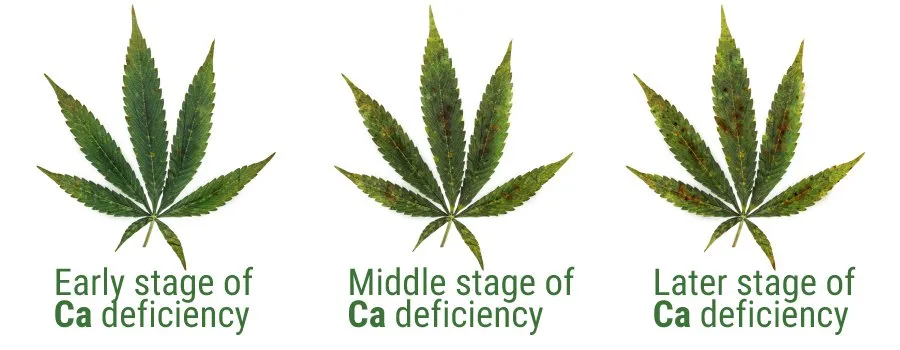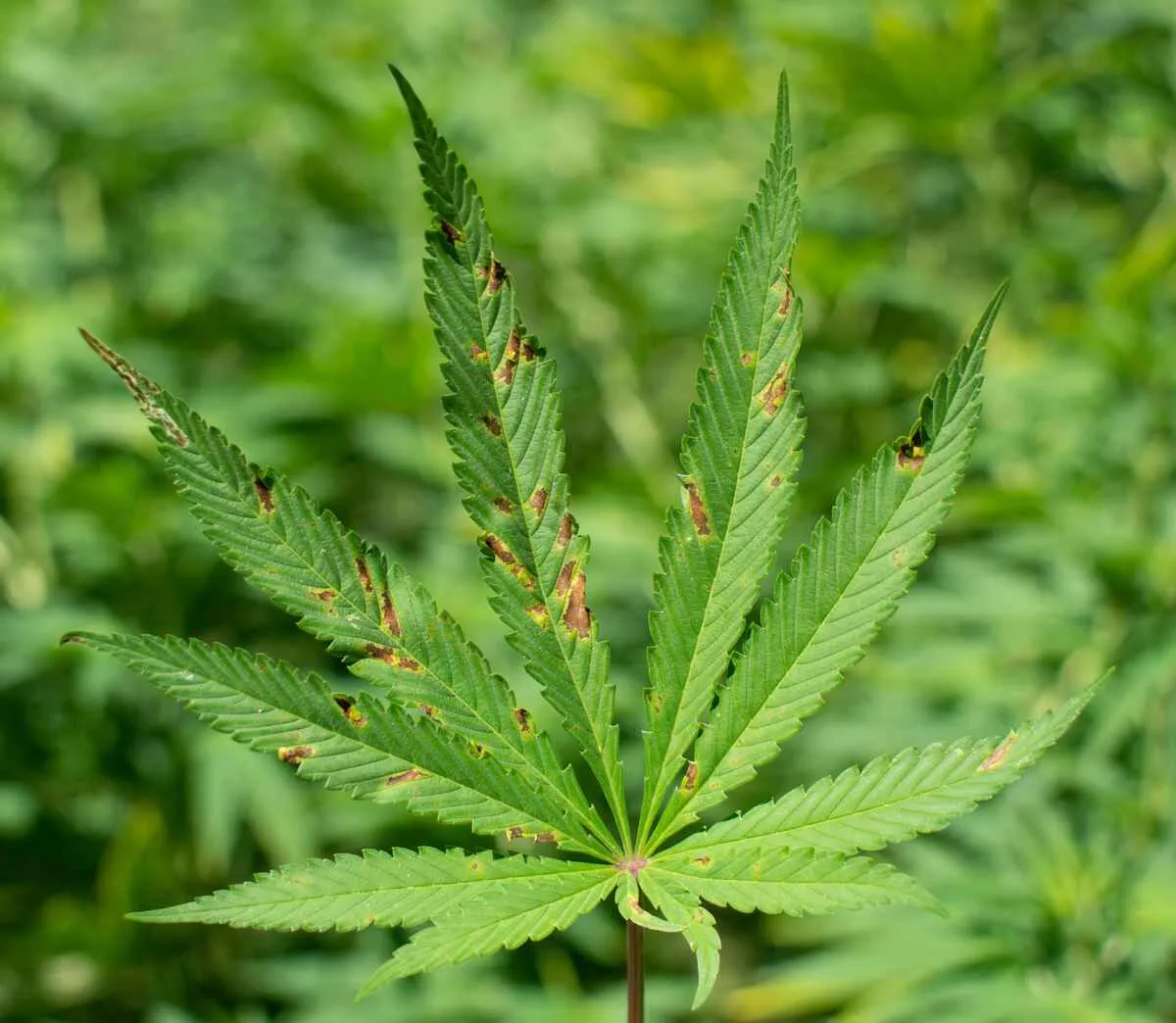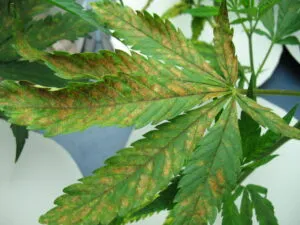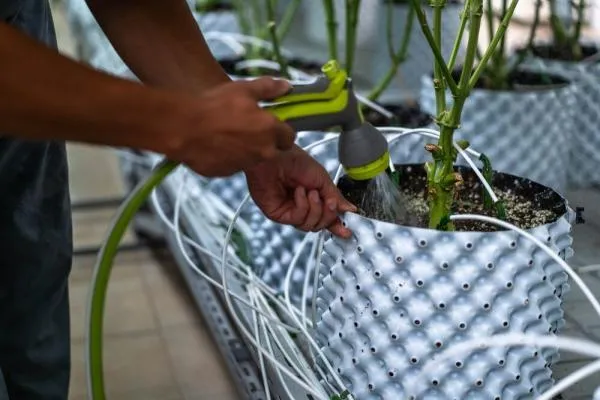Calcium may not be a macro nutrient for the marijuana plant. But a calcium deficiency can have very serious effects and if left untreated, could have a negative effect on the ultimate yield of buds come harvest time. A calcium deficiency can show up in a number of ways on a cannabis plant,. It most often appears as brown spots on cannabis leaves. The good news for growers is that most marijuana deficiencies can be fixed if treated early enough.
- Why do Marijuana Plants need calcium?
- How to fix calcium deficiency in a marijuana plant
- How do you know if your cannabis plant has a calcium deficiency?
- What are the Early Signs of Cannabis Calcium Deficiency?
- What causes calcium deficiency?
- Does cannabis need calcium during the flowering stage?
- Can Overwatering Cause Calcium Deficiency?
- Conclusion
Why do Marijuana Plants need calcium?
Calcium is absorbed by the cannabis plants through the soil, or other growing medium. Once absorbed by the root system, the calcium will travel to the leaves and remain there. This is different than other types of nutrients, which can travel from leaf to leaf, going wherever they’re needed.
Calcium is essential for growth and helps form the cell walls of the plant. This is particularly true in the plant’s roots, where it helps to strengthen the root system and promote root hair growth. Calcium also helps the plant absorb other nutrients, making it an essential part of overall growth.
Typically soil has an abundance of calcium, so plants grown outdoors or indoors in potting soil aren’t very vulnerable to calcium deficiency. Hydroponic setups are more susceptible to this type of deficiency. However, it can occur in any type of grow setup. For this reason, growers need to be able to recognize the signs of a calcium deficiency in order to treat it as soon as possible.
How to fix calcium deficiency in a marijuana plant
When a deficiency is suspected, the ph level of the grow medium needs to be tested before any treatment begins. Without proper ph levels, any added calcium won’t be absorbed by the plant anyway.
Ph levels in soil
Growers using soil should always keep their ph levels between 6.0 and 7.0. Calcium however, is best absorbed when the level is above 6.2, so keeping the ph a bit higher than the minimum is advised.
Ph levels in hydroponics
Hydro setups should have a ph level between 6.2 and 6.5 for the calcium to be best absorbed by the roots.
The system should be cleaned with fresh water that has a proper ph level. This will help restore ph levels and wash away any nutrient salts that may cause a problem when more nutrients are added.
Once the ph levels have been properly balanced, more calcium can then be given to the plant. There are many supplements on the market including Cal-Mag, which will work in soil, hydro, and coco coir setups.
What are the best sources of calcium for cannabis?
- Dolomite lime is great for those growing organic cannabis.
- Fish bones, seashells, and even crushed up eggshells can help provide additional calcium to the plants over time.
These are all great options for organic growers.
When a plant has an excess of calcium, the best thing to do is to empty the system and completely replenish it with ph-balanced water. The roots should also be gently rinsed, if possible, to remove any excess nutrient residue. Then the recommended amount of calcium can be given, as though starting from scratch.
Once calcium deficiencies in plants have been treated, the leaves and other parts of the plant should start to show signs of recovery in about five days.
How do you know if your cannabis plant has a calcium deficiency?
A calcium deficiency can sometimes be hard to spot, as it can mimic the signs and symptoms of other types of nutrient deficiencies. However, there are a few telltale signs one can look for.

These signs will typically start to show first in the newer leaves at the top of the plant.
- As that growth slows, the affected leaf will being to curl. If left untreated, it will become twisted and die off.
- Any new shoots that develop in its place may appear purple or yellow.
- As the growth starts to slow, brown spots on the cannabis leaf will start to develop. When the deficiency starts these may be light, and only appear in a few areas of the marijuana leaf.
- As the plant becomes more deficient in calcium, the spots will darken and will rapidly spread throughout the entire leaf.
- A symptom of this deficiency that is harder to spot is a weakened root system.
This negative effect can often be seen when plants start to lose their luster. The branches may be become weak and break easily. The stalk may feel hollow, and may even start to bend or snap.
As the plant starts to reach maturity, the yield of the plant will also be greatly affected. Buds may be distorted, or they may simply not completely fill out because they did not have the calcium needed to support any new growth. Once a calcium deficiency is present, the plant will also stop responding well to heat.
What are the Early Signs of Cannabis Calcium Deficiency?
Early signs of calcium deficiency in cannabis include:
- Yellowing or browning at the edges of young leaves: The tips and edges of new growth sometimes turn yellow or brown.
- Stunted growth: Growth slows down, and your plants will look smaller and weaker than expected.
- Weak stems: The stems of your cannabis plants sometimes become weak and brittle, making them more prone to damage.
- Spotting on leaves: You might notice small, rusty spots on the newer leaves.
What causes calcium deficiency?

The first is when not enough calcium has been added during the growing process. This can happen when the nutrient balance is simply off, or when no additional calcium has been added to the growing medium.
Growing in soil
As soil is typically high in calcium, plants grown outdoors or in nutrient-rich soil will likely not suffer from a deficiency. If they do, it is often because the soil is too acidic. This happens when the ph level of the soil becomes too high and therefore, prohibits the absorption of any nutrients.
Growing in hydroponics
Water is not naturally rich in calcium. So plants in hydroponic setups or other non-soil mediums, such as coco coir, will be more susceptible to a calcium deficiency. While reserve osmosis water is the best kind to use when growing, all the nutrients will be removed from it. If these are not replaced, plants may start to show signs of a deficiency.
In addition to being deficient in calcium, plants can also receive too much calcium. When a calcium excess occurs, the plant won’t be able to absorb other important nutrients such as potassium, magnesium, manganese, and iron. Small black or burned spots on a marijuana leaf, are the first signs of excessive calcium in the plant. As the plant won’t be able to absorb these nutrients, the leaves may also wilt and overall growth may be stunted.
Does cannabis need calcium during the flowering stage?
Yes, cannabis needs calcium throughout their growth from start to finish. Calcium plays a key role in the development of the plants cell walls and nutrient uptake.
During the flowering stage, cannabis plants require even more calcium because it actually aids the transport of nutrients to the rest of the plant and allows for the rapid development of the flowers. Without a good supply of calcium during flowering, your buds will suffer and your yields will be smaller.
Can Overwatering Cause Calcium Deficiency?
Yes, overwatering your cannabis plants can cause calcium deficiencies, this is because if your soil contains excess water it will reduce how much oxygen it can hold which in turn limits how many nutrients the roots are able to absorb, calcium included, this is known as nutrient lockout.
Conclusion
Marijuana plants love calcium and will generally absorb and use as much as it’s given. There are times though when plants can start to become calcium-deficient, particularly when grown hydroponically, or in other non-soil setups such as coco coir.
Like any other type of deficiency, it’s important that growers always keep on eye on their cannabis plants and ensure they are healthy, vibrant, and growing well. Doing so will ensure a deficiency can be found and treated right away.










